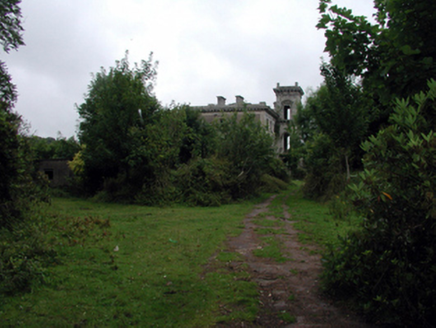Survey Data
Reg No
22803035
Rating
National
Categories of Special Interest
Architectural, Artistic, Historical, Social, Technical
Previous Name
Mayfield
Original Use
House
Historical Use
Office
Date
1830 - 1850
Coordinates
246276, 115305
Date Recorded
24/07/2003
Date Updated
--/--/--
Description
Detached seven-bay three-storey over basement Italianate house, c.1840, on an almost-symmetrical plan incorporating fabric of earlier house, c.1740, with four-bay three-storey Garden elevation to south-west originally having service range to south-west. Renovated, 1857, with single-bay three-stage higher Italianate entrance tower added to centre on a square plan, seven-bay single-storey double-pile lateral wing to north-west having paired single-bay single-storey bows to north-west, seven-bay single-storey single-pile lateral wing to south-east (originally conservatory), and service range to south-west removed. Subsequently in use as offices. Now in ruins. Hipped slate roofs now gone behind parapets with granite ashlar chimney stacks, and traces of cast-iron rainwater goods. Remains of barrel-vaulted roof to wing to south-east with iron ribs on moulded cast-iron cornice. Roof to entrance tower not visible behind. Unpainted rendered walls with channelling to ground floor, stringcourse over, full-height corner pilasters to upper floors supporting plain frieze having projecting cornice with modillions, and blocking course to parapet. Unpainted rendered panelled parapets to wings on moulded cornices having rendered coping. Square-headed window openings to main block (in square-headed recesses to ground floor) with cut-stone sills on consoles (forming sill course to first floor), and moulded surrounds having segmental pediments to first floor on elongated consoles. Remains of 6/6 timber sash windows with some 2/2 timber sash windows to side (north-west) elevation. Round-headed window openings to second stage to entrance tower with projecting sills on consoles, moulded surrounds, and deep panelled hoods over. Square-headed window openings to top stage to entrance tower on consoled projecting course with segmental pediments on elongated consoles. Fittings now gone. Round-headed door openings to first stage to entrance tower (leading into barrel-vaulted corridor) with moulded surrounds having deep panelled hoods over. No fittings. Series of round-headed openings to front (north-east) elevation of wings (some blind) in round-headed recesses with square-headed window openings to remaining elevations. Fittings now gone. Interior now in ruins with some floors partly collapsed, outlines of red brick-lined fireplaces, and evidence of coved plaster ceilings on timber batons. Set back from road in own grounds with avenue to entrance, and overgrown grounds to site.
Appraisal
An imposing, well-composed, substantial house built for the Malcomson family to designs prepared by William Tinsley (1804 – 1885), and reputed to incorporate the fabric of an earlier house, thereby attesting to a long-standing presence on site. A range of stylistic features enhance the architectural design quality of the composition, including bow-ended wings, which are a trait common to further Malcomson properties, including Woodlock (House) (22803001/WD-08-03-01), and Villa Marina, Dock Road, Dunmore East (22817021/WD-27-17-21), and which attest to the later intervention by John Skipton Mulvany (1813 - 1871). The house is distinguished by the elegant entrance tower, which augments the Italianate Classical quality of the composition. Now in ruins, and having been exposed to architectural salvage, much of the original fabric has been lost, although the remains of some fine detailing to the openings survive intact, contributing to the design quality of the site. The construction of the barrel vault to one wing, now exposed, may be considered to be of some technical interest. The house forms an elegant centrepiece in extensive grounds originally accommodating the Malcomson cotton factory complex, and remains an imposing, although increasingly obscured, landmark of some Romantic quality in the townscape.













